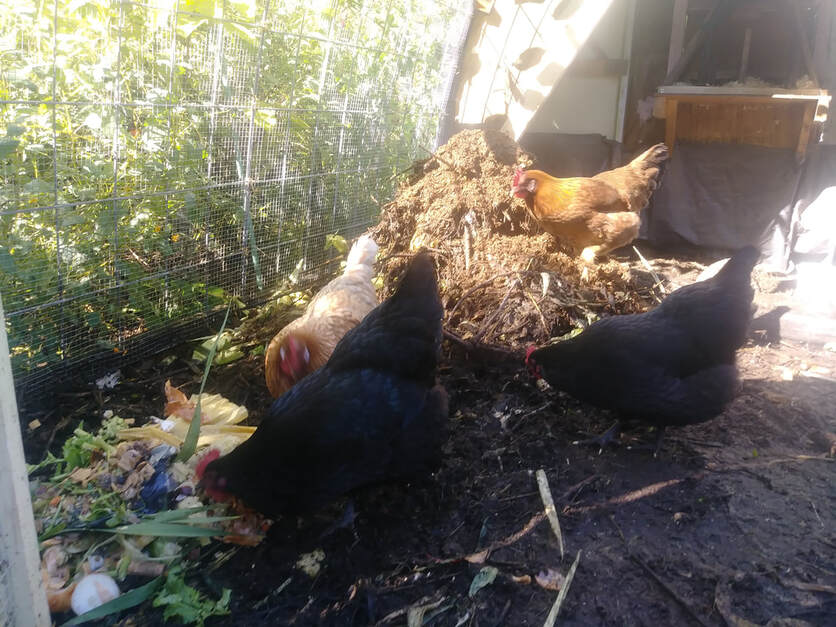 My sister Sabine and her partner Lowie have 15 old-fashioned chickens. They scratch around in their half-acre garden, among woods, debris, grass, and flowers (grr!), munching bugs and greens Sabine and Lowie don’t feed them except the occasional food scrap bin; the garden sustains them just fine, even in the winter (they live in Belgium). If these were modern chickens, each chicken would be getting 1/4 lbs of grain every day, or about 1,500 lbs of chicken feed per year for the flock. It requires modern agriculture about half an acre to grow 1,500 lbs of dry grain and soy. But wait, that’s impossible! Our hyper-productive, advanced agriculture system needs as much land to grow food for 15 chickens (with lots of fossil fuel input), as those chickens get just scrounging around and feeding themselves in a garden?! Somebody must be joking! I visited my sister’s flock just as I had seriously begun to question our own chicken grain-feeding at Big Foot Food Forest. It started with a terrible realization. We order a 1000-pound delivery of chicken feed for our 100 hens (and some roosters) from the local farmers coop every five weeks. On the terrible realization day, I figured out those deliveries add up to 10,000 pounds per year! I had never computed this before. Isn’t it funny how we can overlook the obvious? 10,000 pounds. My gut told me something was very wrong here. Are we feeding too much? Last year, we had about 100 chickens, meaning each chicken got around 100 pounds of feed that year. This jives with what chicken literature says online and in books: laying hens eat about 1/4 pound of grains per day, times 365 days equals about 100 pounds. OK, so that seems right, maybe a little much. Then I asked myself how many eggs we’re getting out of that. Of the 100 chickens about 90 (it’s hard to count them) are laying hens. Last year, we produced nearly 1000 dozen eggs, or 12,000 individual eggs, 133 per laying chicken. Hm. We have heirloom chickens, not super-layers, but still, we’d like to be closer to 150 per hen. Something to investigate. In terms of food, 10,000 pounds resulted in 12,000 eggs, a little more than .8 pounds (13 ounces) for one egg. An egg weighs 2 ounces ounces, so the weight conversion of feed to egg is 6.5:1. Not great, but it gets worse. An egg is mostly made of water and water has no food value. What we really want is a calorie conversion. Grains are dense in calories. Chicken feed has about 1400 calories per pound. One egg has about 55 calories. Even before doing the math, I could see it was pretty bad, but here is the math: we feed.83 pounds per egg, equivalent to 1200 feed calories to produce 55 egg calories, or, 21 feed calories are converted to one egg calorie! I truly don’t want to become vegan, but obviously, there is a real problem here. Our farm has some hefty inefficiencies - we have heirloom chickens, not super-layers; we let our hens live longer and that includes less productive years; we leave them their laying rest period during darker winter-months, we have roosters, and I am sure we could improve. Say we had 100 hens laying 300 eggs a year (industrial farm factory numbers). We would get 30,000 eggs, or one-third pound of feed per egg. That works out about 500 feed calories per 55 egg calories, a ratio of 9:1. Even that is far from great. When you’re that far off, you need more than tweaks; you need a wholesale turnaround. I started thinking (not the first time!) about non-feed options for feeding chickens.  Food scraps When we lived in Needham, we raised four chickens without purchased feed and wrote a series of blog posts about it (see earlier Chicken Letters). We learned about food scrap-based feeding from Karl Hammer at the Vermont Composting Company. He has 600 chickens, and he inspired our Needham system. Our four chickens lived on the food scraps from our household and four neighbors. An average household bucket was half full (about 10 pounds) so our chickens would get about 50 pounds of scraps per week. This converts to almost two pounds of scraps per hen per day – they ate the scraps directly plus grubs and worms growing in their left-overs and left plenty. Their laying was terrific (four eggs almost every day for the first year). When we moved to the farm, we were not able to scale this system up. To fully feed our 100 chickens, I think we would need the food scraps from about 70 households. Even if we had 20-25 households, it would make a big dent in our imported grain purchases. Plan: send out direct mailing postcards to neighbors in our village asking if they will join our food-scrap pickup route. Pasture grazing A more common way to reduce feed needs is to move chickens around on pasture, especially following larger livestock like cows and sheep. The hens sleep and lay in a mobile coop that the farmer moves around, and their daily pasture is enclosed with an electric fence. They eat some grass, grubs and bugs in the grass, and grubs in the livestock poops. They fertilize the fields as they go along. I have read that this can provide hens with up to 30 percent of their food needs. Now guess what: we happen to have built a chicksaw last year for 30-40 hens just last summer! Hence, plan: to move the chicksaw around behind the sheep for at least a few months this summer and see how pasture grazing works for us. Chicken food forest,
A third option is to grow food for chickens on the farm – a planned, intentional version of what Sabine and Lowie have in Belgium. We could grow fruits, vegetables, greens, worms and grubs. I’ve not pursued growing feed up to now because as it’s described in online blogs of homesteading books, it’s focused on annual grains and seems like a lot of work. But if we put on our permaculture hats and focus on trees like mulberries, which produce copiously year after year with little care once they are established, it gets more interesting. What about, other tree fruits, berries, and perennials like comfrey? Thinking it through and poking around the web, there is a lot of potential here. Now it’s getting interesting…. The idea of the chicken food forest was born. We would have to figure out what plants provide the most food, and protect the plants and soil to deal with chickens’ tendency for destruction (usually chicken yards are desolate), but it will be fun. Plan: design and implement a chicken food forest. Spent brewer’s grain Just as I was writing this, Charlotte (our daughter) sent me a note that a local brewery, Brick and Feather, was looking for a new farmer to pick up their spent grain. What a happy coincidence! I jumped on the opportunity thinking we could do away with purchased feed and just use supply brewer’s grain. I arranged to pick up grains every week or every other week. We will be getting about 100 gallons of spent grain weekly, about 400 pounds. Hooray! In somewhat typical fashion, after making this arrangement I started doing research on what to do with it. Disappointingly, you cannot just substitute spent grain for all your feed. It is high in protein and fiber and can be used to substitute for the soy in chicken feed and, according to research, it can be up to 20 percent of the total chicken diet. By itself it spoils very quickly; to create a stable product you have to ferment it. Not quite as simple as I had thought! Still, 20 percent is good, fermenting is doable, and also, mixed with carbon, spent grain composts very quickly and can be used to produce worms and little chicken tid-bits, with super-valuable fertilizer as an extra by-product. So, it will be useful to us, and we will figure out a way to use it. Plan: figure out a plan! I’m glad to be getting back to this and grateful for the 10,000 pound wake-up call. Stay tuned for updates as we go… Hopefully not too many crashes.
0 Comments
Leave a Reply. |
Babette WIlsBabette is a permaculture farmer in Western Massachusetts. She and people who are working with her on the farm are experimenting and learning on the go. Archives
April 2024
CategoriesHappy 2024!It’s 2024 and we are excited for this coming year. Lots of plans: integrating trees and livestock in silvopasture; working with other farmers in the area to promote agroforestry and make it a viable farming option; expanding our berry patches; and of course continuing our offerings at the Greenfield and Turners Falls farmers markets with our partner Just Roots!
|

 RSS Feed
RSS Feed